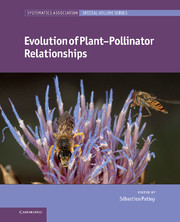Book contents
- Frontmatter
- Contents
- Contributors
- Preface
- 1 Macroevolution for plant reproductive biologists
- 2 Pollination crisis, plant sex systems, and predicting evolutionary trends in attractiveness
- 3 Evolution and ecological implications of “specialized” pollinator rewards
- 4 Fig–fig wasp mutualism: the fall of the strict cospeciation paradigm?
- 5 Fossil bees and their plant associates
- 6 Pollen evidence for the pollination biology of early flowering plants
- 7 Pollinator mediated floral divergence in the absence of pollinator shifts
- 8 Animal pollination and speciation in plants: general mechanisms and examples from the orchids
- 9 Why are floral signals complex? An outline of functional hypotheses
- 10 A survey on pollination modes in cacti and a potential key innovation
- 11 Zygomorphy, area, and the latitudinal biodiversity gradient in angiosperms
- 12 Ambophily and “super generalism” in Ceratonia siliqua (Fabaceae) pollination
- 13 Structure and dynamics of pollination networks: the past, present, and future
- 14 Pollinators as drivers of plant distribution and assemblage into communities
- 15 Effects of alien species on plant–pollinator interactions: how can native plants adapt to changing pollination regimes?
- 16 Pollen resources of non-Apis bees in southern Africa
- 17 Advances in the study of the evolution of plant–pollinator relationships
- Index
- Plate section
- References
9 - Why are floral signals complex? An outline of functional hypotheses
Published online by Cambridge University Press: 05 January 2012
- Frontmatter
- Contents
- Contributors
- Preface
- 1 Macroevolution for plant reproductive biologists
- 2 Pollination crisis, plant sex systems, and predicting evolutionary trends in attractiveness
- 3 Evolution and ecological implications of “specialized” pollinator rewards
- 4 Fig–fig wasp mutualism: the fall of the strict cospeciation paradigm?
- 5 Fossil bees and their plant associates
- 6 Pollen evidence for the pollination biology of early flowering plants
- 7 Pollinator mediated floral divergence in the absence of pollinator shifts
- 8 Animal pollination and speciation in plants: general mechanisms and examples from the orchids
- 9 Why are floral signals complex? An outline of functional hypotheses
- 10 A survey on pollination modes in cacti and a potential key innovation
- 11 Zygomorphy, area, and the latitudinal biodiversity gradient in angiosperms
- 12 Ambophily and “super generalism” in Ceratonia siliqua (Fabaceae) pollination
- 13 Structure and dynamics of pollination networks: the past, present, and future
- 14 Pollinators as drivers of plant distribution and assemblage into communities
- 15 Effects of alien species on plant–pollinator interactions: how can native plants adapt to changing pollination regimes?
- 16 Pollen resources of non-Apis bees in southern Africa
- 17 Advances in the study of the evolution of plant–pollinator relationships
- Index
- Plate section
- References
Summary
Introduction
Plants produce a remarkable variety of displays to attract animals that transfer pollen. These floral displays are usually complex, broadcasting various combinations of visual, olfactory, gustatory, tactile, and thermal stimuli (Raguso 2004a). Even acoustic stimuli may be involved, as in the case of structural nectar guides used by echolocating flower-feeding bats (von Helversen and von Helversen 1999). Yet these sensorially complex advertisements likely evolved from an ancestor that primarily transmitted only chemicals, serving a defensive function (Pellmyr and Thein 1986). The subsequent amplification and elaboration of floral stimuli therefore offers an intriguing opportunity to study signal evolution. However, at present, we know surprisingly little about why floral displays consist of so many elements. This contrasts with progress in other areas: recently, researchers studying topics as diverse as sexual selection, warning displays, animal learning, and parent–offspring communication have explored the function of signal complexity (Rowe 1999; Candolin 2003; Hebets and Papaj 2005; Partan and Marler 2005).
Researchers studying plant–pollinator interactions, however, have not to date shown a comparable degree of interest in the topic of complex signals, as judged by an analysis of the research literature. An August 2010 search on the ISI Web of Science® database on journal articles published since 1995 returned only two on plant–pollinator topics containing the words “multimodal” and “signal-” in their titles, abstracts, or keywords (those articles being Raguso and Willis 2002; Kulahci et al. 2008). In comparison, the same search returned 59 articles on sexual selection topics.
- Type
- Chapter
- Information
- Evolution of Plant-Pollinator Relationships , pp. 279 - 300Publisher: Cambridge University PressPrint publication year: 2011
References
- 14
- Cited by



